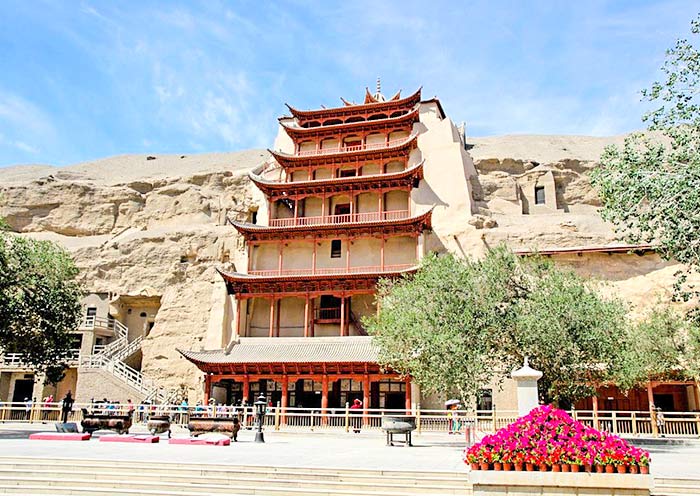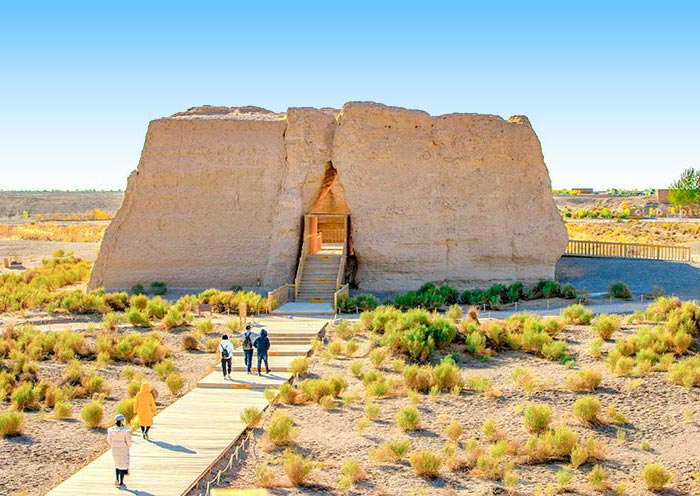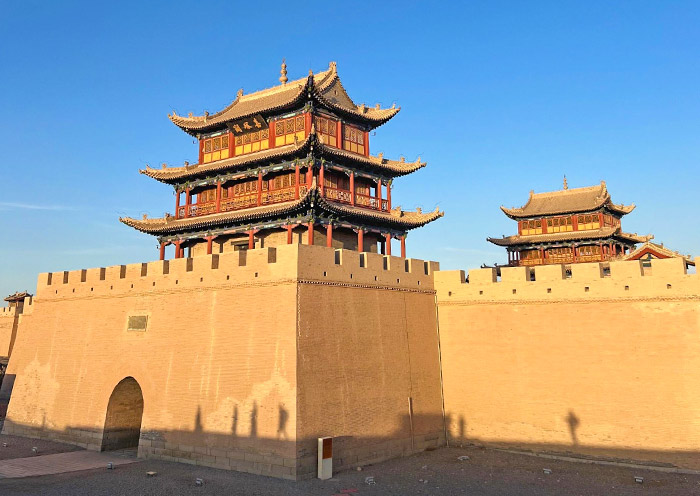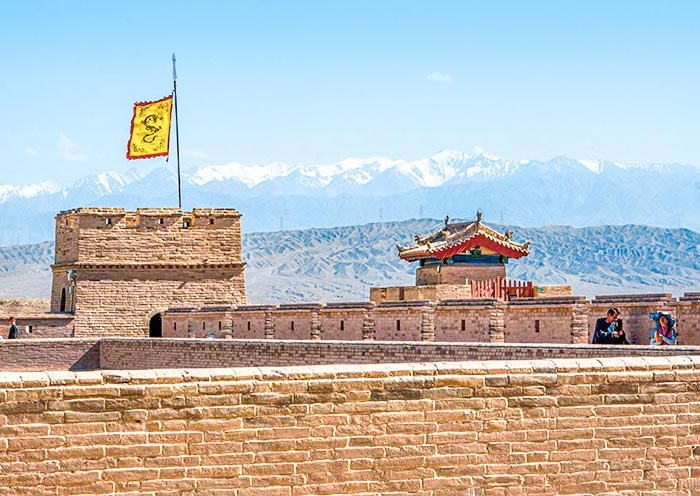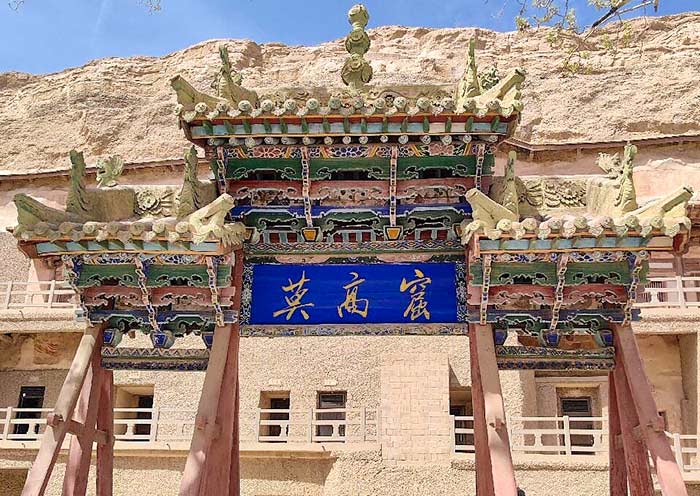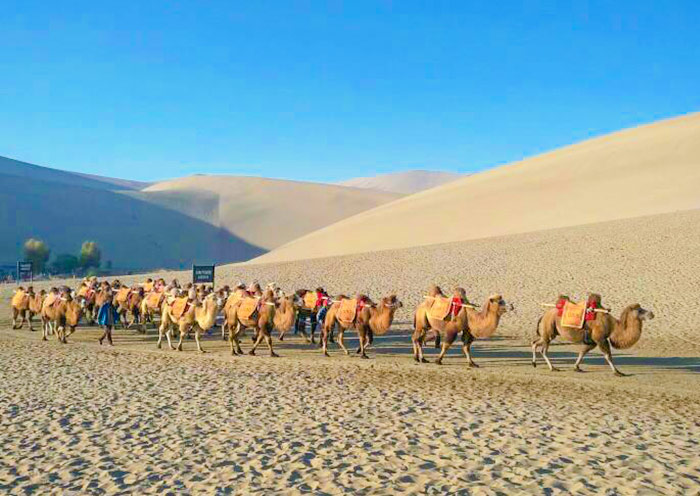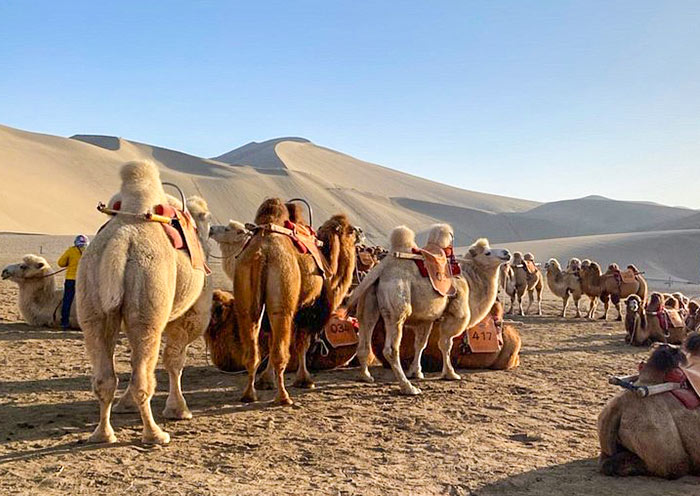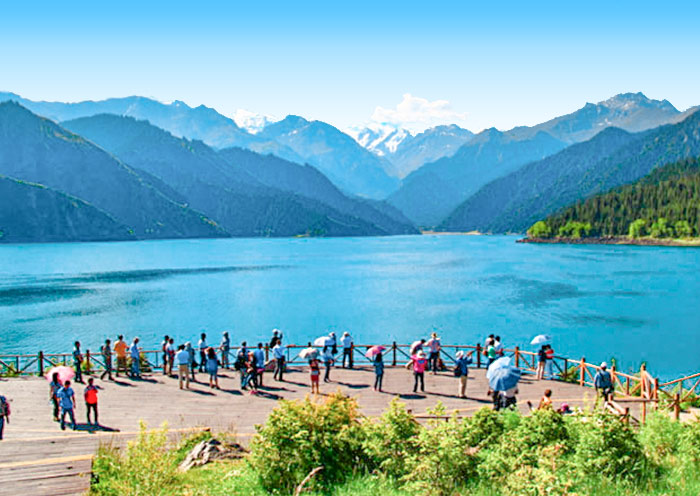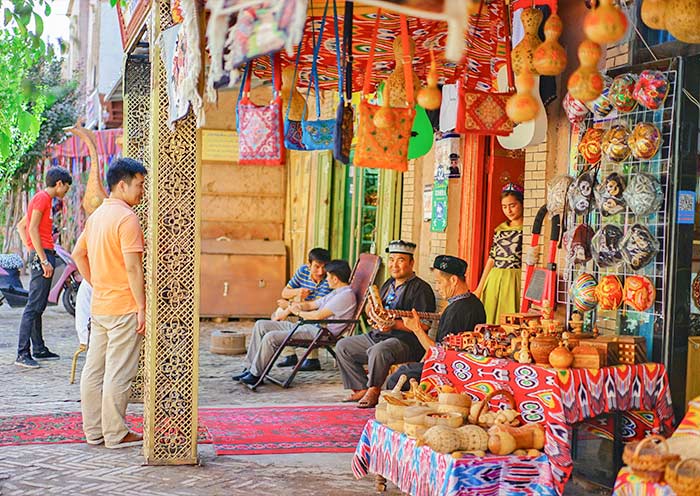No.1 Mogao Caves - Best Things to Do in Dunhuang
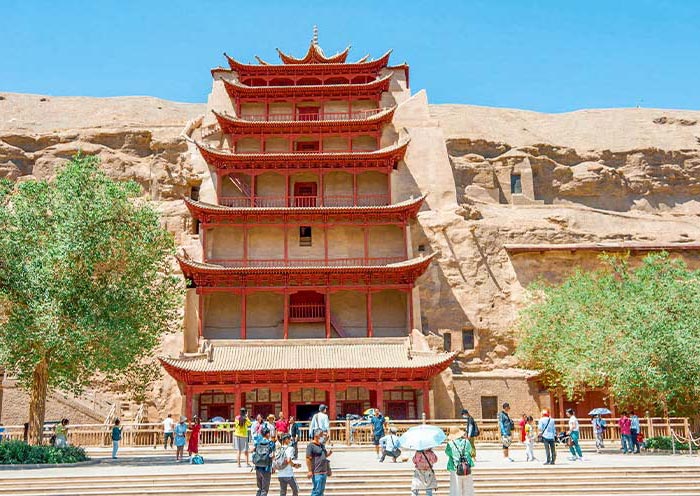
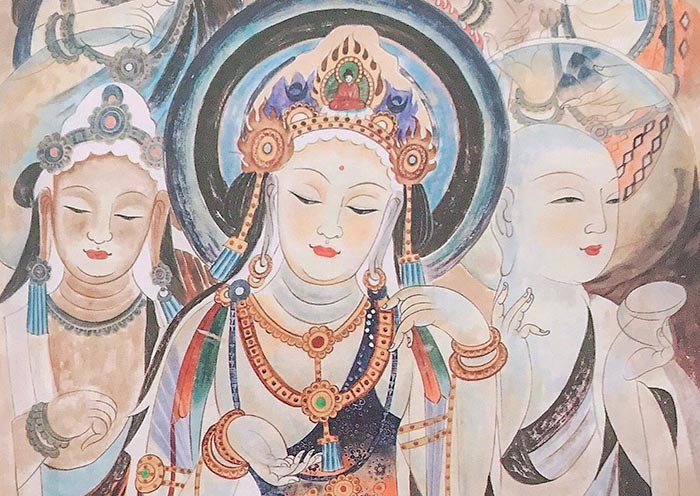
The Mogao Caves, a UNESCO World Heritage Site, are one of the most impressive archaeological finds in the world. Known as the "Caves of a Thousand Buddhas," they showcase stunning Buddhist art dating back to the 4th century. With 735 caves along cliffs about 15-30 meters high and over 1,700 meters long, the murals and sculptures offer a fascinating glimpse into the artistic and cultural exchanges of the Silk Road.
Located 25 kilometers southeast of Dunhuang city center, you'll first head to the Digital Exhibition Center about 9 kilometers from the city to watch an introductory film. Then, take a shuttle bus 16 kilometers to the Mogao Caves site. The visit usually takes half a day to a full day. You'll explore 8 caves, with specific ones depending on conditions. Afterward, you can visit special caves for an extra fee.
If you want to take photos, check out the Heritage Protection Exhibition Center for 1:1 replicas of 8 special caves, including caves 275, 249, 285, 419, 220, 217, 25, and 3.
What to See in Magao Caves
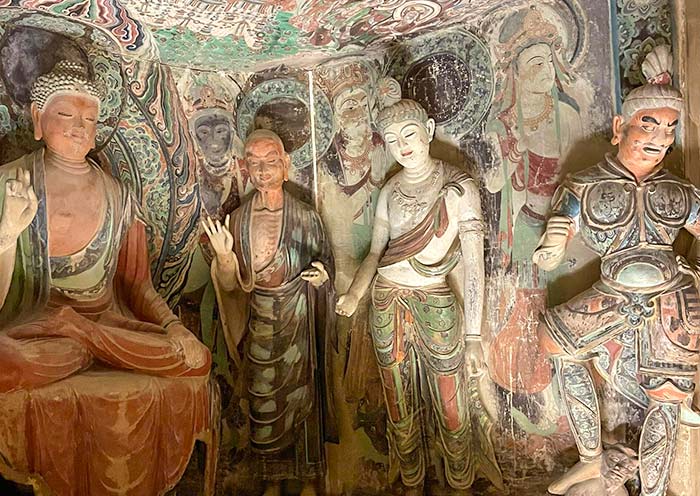
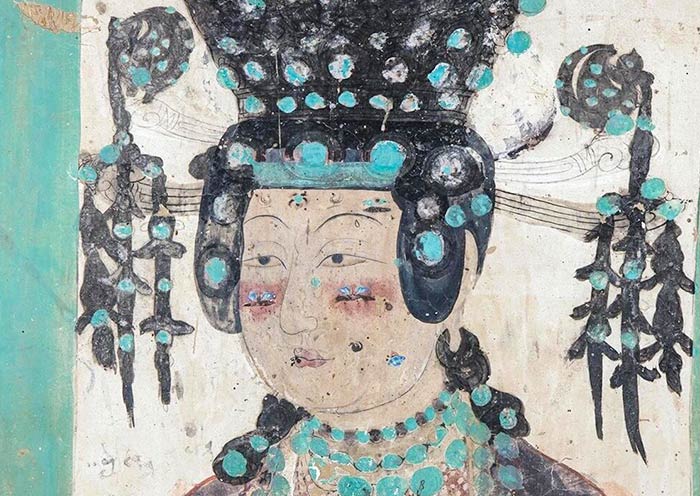
Various types of cave architecture: The caves were built with different designs based on their era and purpose, like the Nirvana Caves (148/158), Central Pillar Caves (428), and Temple Caves (249).
Murals: Stunning paintings depicting Buddhist stories and Silk Road history.
Library Cave: Explore the hidden manuscripts and artifacts.
Clay Sculptures: Remarkable statues made with wooden frames and clay, painted with colorful garments. These include Buddha, Bodhisattvas, and guardian deities. Over 3,000 painted sculptures still exist in the Dunhuang caves.
Which Caves in Mogao Caves to See
- Cave 96: Known for the giant Buddha statue, it's an impressive sight.
- Cave 16 and 17: Famous for the discovery of the Library Cave, containing thousands of ancient manuscripts.
- Cave 148: Features beautiful Tang Dynasty murals.
- Cave 45: Known for its intricate ceiling designs and vibrant murals.
No.2 Singing Sand Dunes (Mingsha Mountain) - Outdoor Paradise
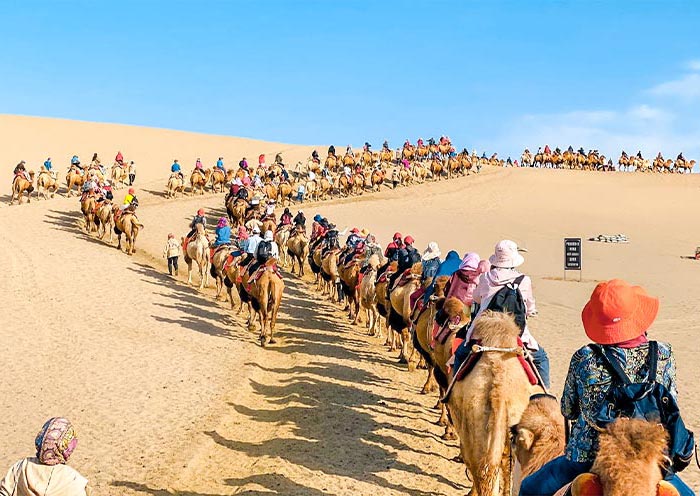

The Mingsha Mountain, or Singing Sand Dunes, is one of the most iconic landmarks in Dunhuang, located about 7 kilometers from downtown. These towering sand dunes are a natural wonder that'll leave you in awe. As you slide down the dunes, the sand beneath you makes a mesmerizing sound, almost like music! It's caused by the sand grains rubbing together.
Climb to the top of the dunes for breathtaking panoramic views of the Gobi Desert and the distant Crescent Lake. The contrast between the golden sand dunes and the shimmering water is simply magical.
The best time to visit is during the early morning or late afternoon when the temperature is cooler, and the light is perfect for photos. For a truly unforgettable experience, try a sunset tour. Watching the sun dip below the horizon and paint the dunes in hues of orange and pink is something you'll never forget.
Things to do in Singing Sand Dunes
Climb to the Top: Hiking to the summit of the sand dunes is a must-do. The panoramic views of the Gobi Desert and surrounding area are simply breathtaking. And don't worry about getting tired – there are often wooden ramps to help you up the steeper parts.
Sandboarding: Feeling adventurous? Try sandboarding! It's like snowboarding on sand. Zoom down the steep dunes for a thrilling ride.
Camel Rides: Hop on a camel and take a leisurely stroll through the dunes. It's a classic desert experience you won't forget.
Watch the Sunset: Catch a stunning sunset over the dunes. The golden hour is the perfect time to capture some amazing photos.
Join the Singing Crowd: During peak season, many visitors gather on the dunes for a communal sing-along. It's a fun and festive atmosphere.
No.3 Crescent Moon Pool - Get Inspired by the Oasis
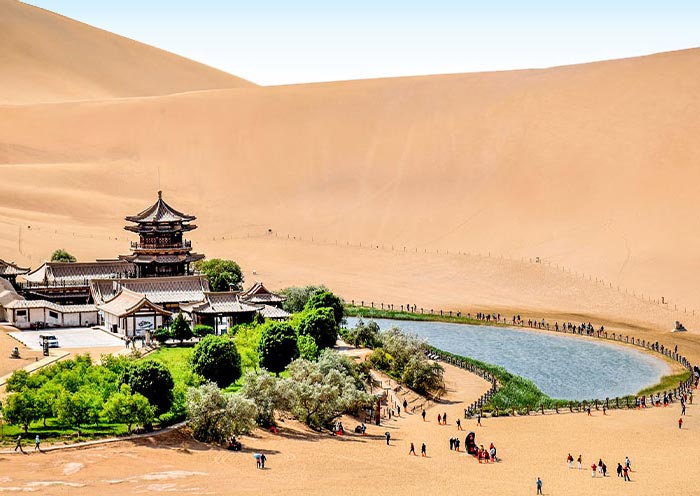

The Crescent Moon Spring, or Yueyaquan in Chinese, is a stunning oasis nestled at the foot of the Mingsha Mountain. This crescent-shaped lake is a breathtaking sight that contrasts beautifully with the golden sands. Despite being in a harsh desert environment, it's survived for centuries thanks to an underground water source. This natural wonder has been a major stop on the ancient Silk Road for ages.
Most visitors explore both the Mingsha Mountain and the Crescent Moon Pool together. After entering the park, you'll usually start at the spring. Then, you can enjoy fun desert activities like camel riding, sandboarding, or dune buggy rides. For a memorable experience, climb up the sand dunes at sunset and watch the sun go down over the desert.
Your Crescent Moon Pool route can be:
Walk: Main Gate - Mingyue Square - Yaowang Temple Ruins - Mingyue Pavilion - Crescent Moon Lake - Climb the Dunes.
Camel Ride: Main Gate - Mingyue Square - Camel Ride to East Mountain - Mingyue Pavilion - Crescent Moon Lake - Climb the Dunes.
Dune Buggy: Main Gate - Mingyue Square - Dune Buggy to East Mountain - Mingyue Square - Mingyue Pavilion - Crescent Moon Lake - Climb the Dunes.
No.4 Yadan National Geological Park - Marvel at the Wonders of Nature
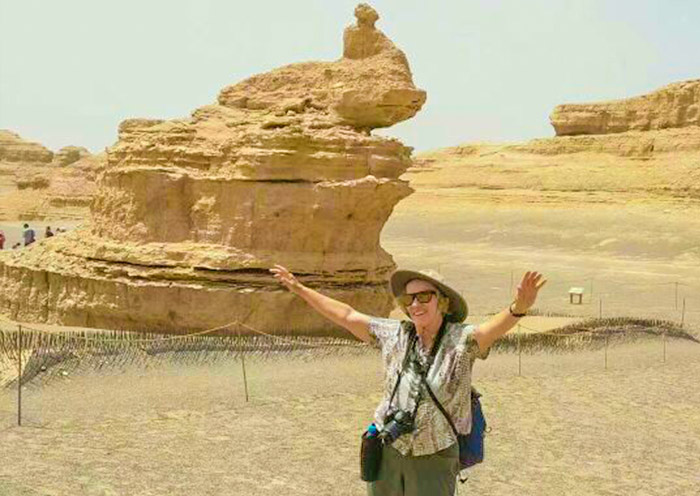
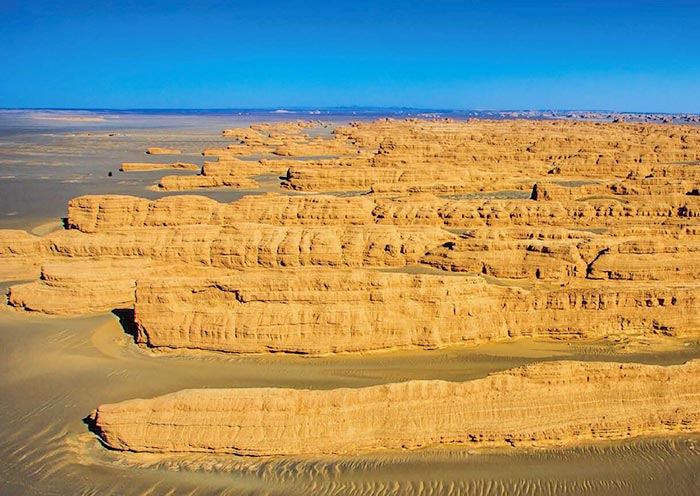
It feels like another planet! Yadan National Geological Park is famous for its amazing rock formations. You'll find everything from towering pillars and narrow canyons to intricate arches and castle-like shapes, creating a surreal experience perfect for photography and adventure.
Located 180 kilometers west of Dunhuang, it takes about 2.5-3.5 hours to drive there, so it's best to set aside a full day for the trip. Once you arrive, a shuttle service in the park will take you to the main viewpoints, ensuring you don't miss any highlights, including spots featured in the famous movie "Crouching Tiger, Hidden Dragon."
Consider visiting in the late afternoon to catch the sunset, which casts dramatic shadows and enhances the park's surreal beauty.
No.5 Yulin Caves - Discover Ancient Art in Tranquil Surroundings
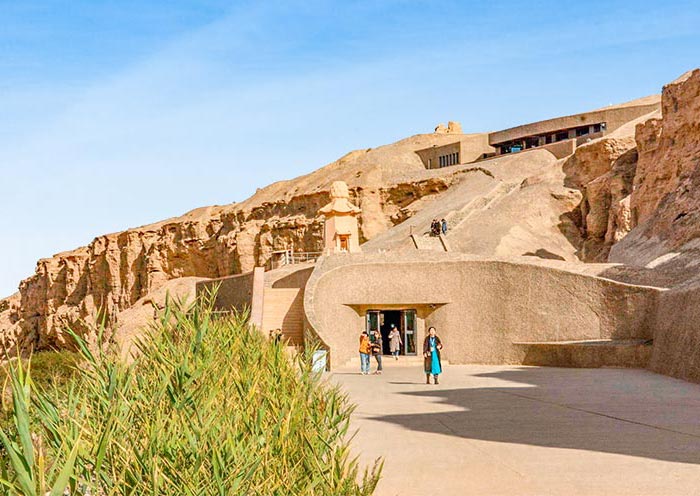
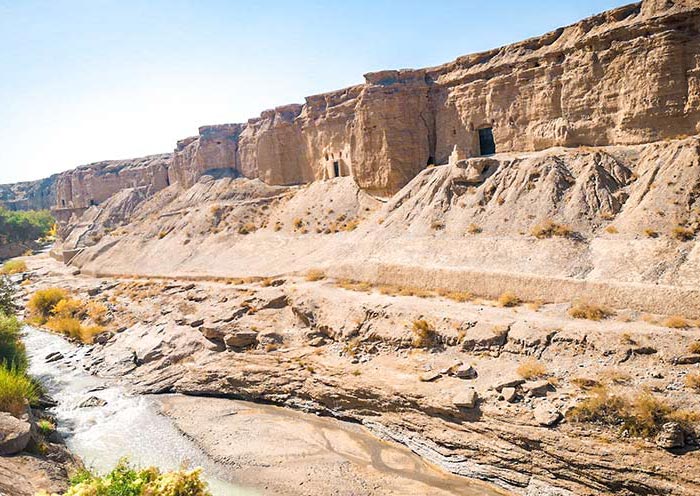
The Yulin Caves near Dunhuang are a must-visit for anyone interested in ancient art and history. Although not as famous as the Mogao Caves, Yulin is perfect for those wanting to explore intricate Buddhist art without the crowds. The well-preserved murals display styles and stories similar to Mogao, but in a more private setting. Plus, the caves are nestled in a beautiful valley, adding a peaceful atmosphere to your visit.
Located about 70 kilometers from Dunhuang, public transport isn't convenient, so joining a tour group is a good idea. Don't miss Cave 25, known for its stunning murals of "The Amitayurdhyana Sutra" and "Maitreya Sutra," praised as the "crown of Dunhuang cave art."
No.6 Yumen Pass & Yang Pass - Gateways to Silk Road History
Yumen Pass
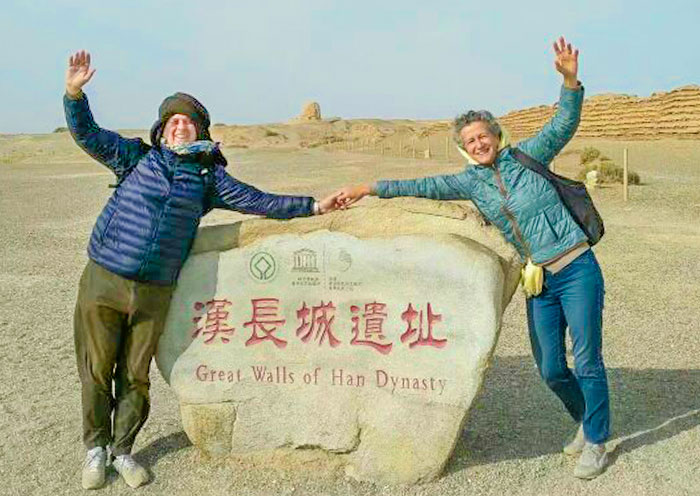
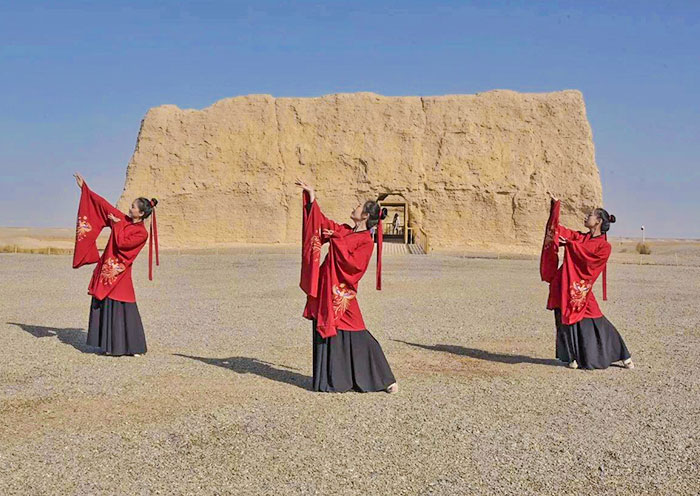
Yumen Pass, located 90 kilometers from Dunhuang in the Gobi Desert, is a historic gateway. It was an important trading post on the Silk Road, linking China with the Western world. A must-visit for history buffs, it offers a unique glimpse into ancient trade routes and cultural exchanges from centuries ago. Standing at this historic site, you can almost hear the echoes of camel caravans and merchants passing through.
The main highlight of Yumen Pass is the ancient fortifications that still stand: a rammed earth wall measuring 24 meters long, 26.4 meters wide, and 9.7 meters high. These remnants highlight the strategic importance of the pass. The surrounding desert landscape adds to the experience, offering stunning views and a sense of solitude.
Yang Pass

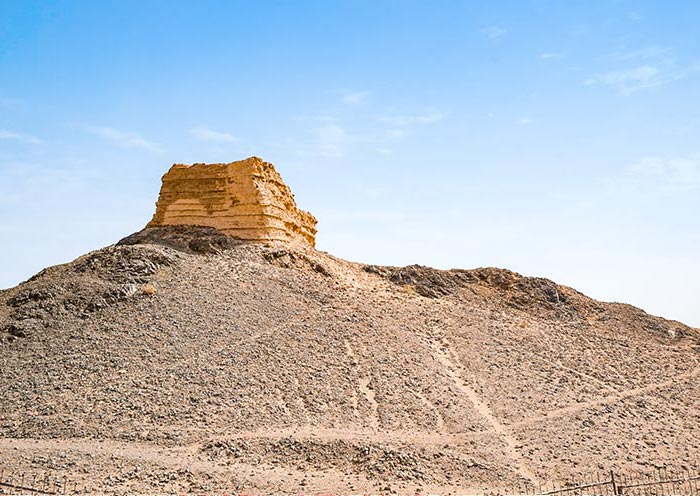
Yang Pass, located 60 km from Dunhuang, is another important gateway of west of Dunhuang. The main historical site is a Han Dynasty beacon tower standing on Dundun Mountain. Standing there, you can gaze over the vast Gobi Desert and the distant Altun Mountains, feeling the solitude of ancient travelers venturing into the unknown.
The Yang Pass area has 4 main parts: museums, the Commander's Office, the beacon tower ruins, and Yangguan Avenue. The visit takes about 2-3 hours.
- Museums: Silk Road Museum and Yang Pass Museum.
- Commander's Office: Experience the historical setting and get a travel pass stamp, simulating the ancient border crossing.
- Beacon Tower Ruins: The only remaining tower on Dundun Mountain, offering panoramic views, known as the "eyes and ears of Yang Pass."
- Yangguan Avenue: Walk this historic road, symbolizing the ancient hope for safe passage to the Western Regions.
No.7 Shazhou Night Market - Dive into Dunhuang's Vibrant Culture
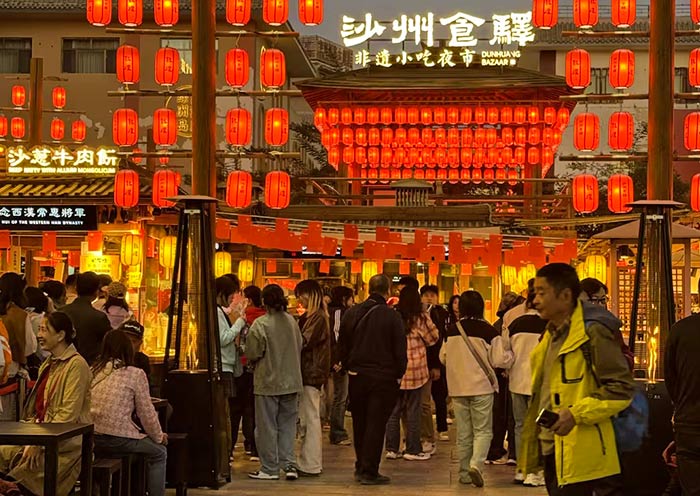

Exploring the Shazhou Night Market in Dunhuang is an absolute must for anyone looking to dive into the local culture and flavors. This vibrant market offers a lively atmosphere filled with the sights, sounds, and tastes of Northwest China.
The market is famous for its diverse food stalls offering everything from spicy lamb skewers to hand-pulled noodles. Be sure to try Dunhuang's famous apricot peel tea. Besides food, you'll find stalls selling handicrafts, silk products, and local artworks. Live music and dance performances add to the vibrant atmosphere, making it a great spot for an evening out.
Located in the heart of Dunhuang, the market is easily accessible by taxi or a short walk from most hotels. It usually opens in the early evening and runs late into the night, so plan to spend a few hours soaking it all in.
No.8 A Silk Road Adventure: Connecting Dunhuang with Other Key Cities
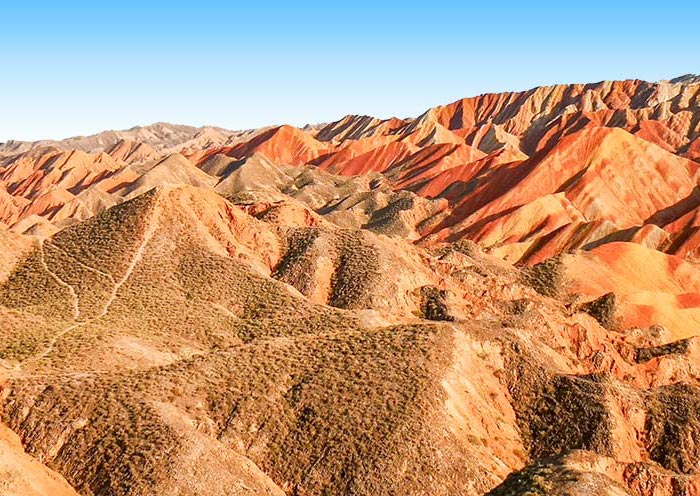
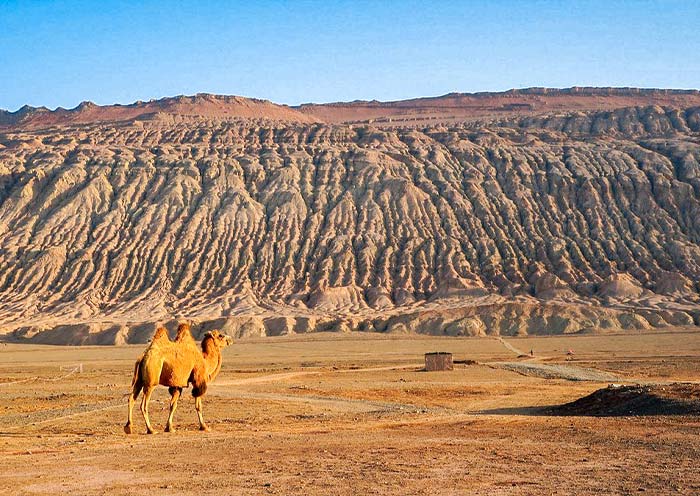
Dunhuang, a city steeped in history and culture, serves as a pivotal point on the ancient Silk Road. To truly appreciate its significance, consider exploring its connections to other important cities along Silk Road.
Highlights of the Silk Road Cities
Xi'an: As the eastern terminus of the Silk Road, Xi'an offers a glimpse into China's imperial past. Explore the Terracotta Army, a breathtaking collection of life-sized clay soldiers, and wander through the ancient city walls.
Lanzhou: Known for its beautiful Yellow River scenery and the stunning Bingling Temple Grottoes, Lanzhou serves as a gateway to the Silk Road.
Zhangye: Famous for the colorful Danxia landforms and the Giant Buddha Temple, Zhangye offers breathtaking natural and cultural sights.
Jiayu Pass: This is the western end of the Great Wall and a symbol of ancient military defense. The pass provides a glimpse into the strategic importance of the Silk Road.
Turpan: Known for its unique desert landscapes and ancient ruins like the Jiaohe City, Turpan is a cultural gem in Xinjiang.
Kashgar: This vibrant city, located near the border with Kyrgyzstan and Tajikistan, is a cultural melting pot. Explore the Id Kah Mosque, one of the largest mosques in China, and immerse yourself in the bustling bazaars.
How to Visit
These cities are well-connected by train and flights, making it easy to plan a Silk Road itinerary. Consider starting in Xi'an and working your way west to Kashgar for a comprehensive experience.
How to Plan a Dunhuang Trip With Top Attractions (Itinerary Ideas)
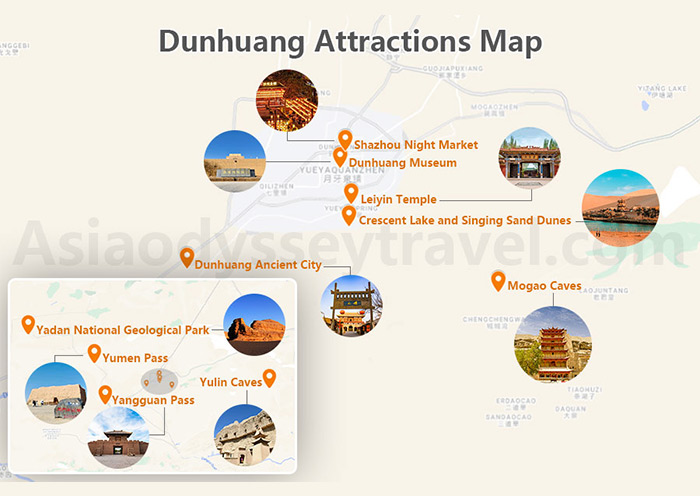

A 1-3 Day Getaway
A 1-3 day trip to Dunhuang is the perfect way to experience the ancient Silk Road. A single day can be dedicated to exploring the iconic Mogao Caves, a UNESCO World Heritage Site renowned for its stunning Buddhist art. Combine this with a visit to the mesmerizing Mingsha Mountain and Crescent Lake, where you can witness the enchanting desert landscape.
If you have extra time, consider venturing further to the Yumen Pass, Yangguan, and the Yadan National Geopark. These sites offer a glimpse into the region's rich history and unique geological formations.
Here's a suggested three-day itinerary for Dunhuang:
Day 1: Arrival in Dunhuang
Day 2: Discover Dunhuang - Spend the day visiting the UNESCO World Heritage-listed Mogao Caves, known for their ancient Buddhist art. Also, experience the unique natural phenomena at Mingsha Mountain and the picturesque Crescent Lake.
Day 3: Dunhuang Explorations - Explore the Yadan National Geopark, visit the historic Yumen Pass, and discover remnants of the Han Dynasty Great Wall, immersing yourself in the region's vast and storied landscapes.
A Comprehensive Gansu Silk Road Tour
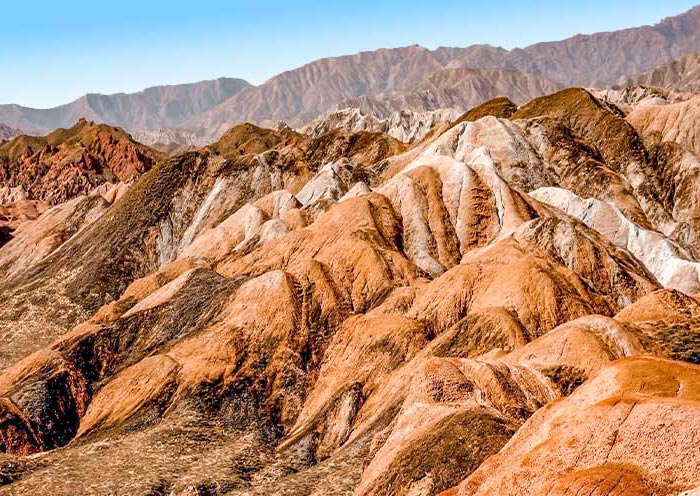

Gansu (6-8 Days)
Lanzhou: Spend 1-2 days in the vibrant capital city of Gansu. Explore its historic sites, sample the delicious Lanzhou beef noodles, and immerse yourself in the local culture.
Zhangye: Allocate 1-2 days to witness the breathtaking Danxia Landform, a geological wonder characterized by colorful rock formations that seem to paint the landscape.
Jiayuguan: Dedicate 1-2 days to the Jiayuguan Fort, the westernmost point of the Great Wall. Explore its impressive fortifications and learn about its historical significance.
Beyond Gansu: Xinjiang & Qinghai
Xinjiang (7-8 Days): Embark on a 7-8 day adventure to Xinjiang, a region steeped in history and culture. Visit the bustling city of Urumqi, the ancient oasis of Turpan, and the historic city of Kashgar. Explore the remote Tashkurgan and the stunning Kanas Lake, each offering unique experiences and breathtaking landscapes.
Qinghai (1-3 Days): Consider adding 1-3 days to your itinerary to explore Xining, the capital of Qinghai Province. Visit the Kumbum Monastery, a significant Tibetan Buddhist site, and enjoy the serene beauty of Qinghai Lake.
Travel with Asia Odyssey Travel (AOT) to Explore Dunhuang, Gansu
Travel to Dunhuang with Asia Odyssey Travel (AOT) and discover the stunning treasures of the Silk Road in Gansu, China. With years of expertise in crafting tours in Northwestern China, AOT offers a variety of customizable tour packages that cater to all types of travelers.
Tour Packages: Dunhuang Tours
Popular Attractions: Mogao Caves, Hexi Corridor
Dunhuang Travel Guide: Dunhuang Attractions, Best Time to Visit Dunhuang, Dunhuang Map
Dunhuang Transportation: How to Get to Dunhuang, Beijing to Dunhuang, Xi’an to Dunhuang, Zhangye to Dunhuang
Extend Your Trip to Gansu & Silk Road
Tour Packages: Gansu Tours, Silk Road Tours, Silk Road Group Tours, China Silk Road Tours, China Northwest Tours
Gansu Destinations: Lanzhou, Dunhuang, Zhangye, Jiayuguan
Gansu Travel: Gansu Travel Guide, Gansu Travel Tips, Gansu Maps, Gansu Attractions, How to Plan a Gansu Tour
Silk Road Travel: Silk Road Travel Guide, Silk Road Cities, Silk Road Trip Planning Guide, Silk Road Itinerary, Silk Road Attractions, Silk Road Map, Silk Road Facts
